
Morgue Myths Debunked—Do They Really Freeze Bodies?
The Truth About Morgue Body Storage
Do morgues freeze bodies? The short answer is no - most standard morgues actually refrigerate bodies at temperatures between 2°C and 4°C (36°F to 39°F), rather than freezing them. This gentle cooling slows decomposition while preserving tissue integrity, which is essential for identification, autopsy procedures, and funeral preparation.
| Morgue Storage Method | Temperature Range | Typical Duration | Primary Purpose |
|---|---|---|---|
| Refrigeration (Standard) | 2°C to 4°C (36°F to 39°F) | 3-4 weeks | Short-term storage, autopsy preparation |
| Freezing (Specialized) | -10°C to -50°C (14°F to -58°F) | Months to years | Forensic cases, long-term storage, mass disasters |
When someone passes away, their body immediately begins the natural process of decomposition. It's a reality none of us like to think about, but it's precisely why morgues use controlled cooling. This cooling significantly slows these natural processes, providing precious time for families to make arrangements, for medical examiners to complete their work, and for funeral directors to prepare for services.
Despite what crime shows might have you believe, most hospital morgues, funeral homes, and medical examiners' offices rely on positive-temperature refrigeration rather than freezing. This approach preserves the body's condition without causing the cellular damage that freezing would create. The dramatic vapor clouds you see on TV when a morgue drawer opens? Pure Hollywood fiction in most cases.
I've spent years helping funeral homes and medical facilities understand the nuances of body preservation. At American Mortuary Coolers, we've answered the question "do morgues freeze bodies" countless times while providing customized cooling solutions to professionals across the country. This experience has given me a unique perspective on the temperature requirements for proper and respectful body preservation.
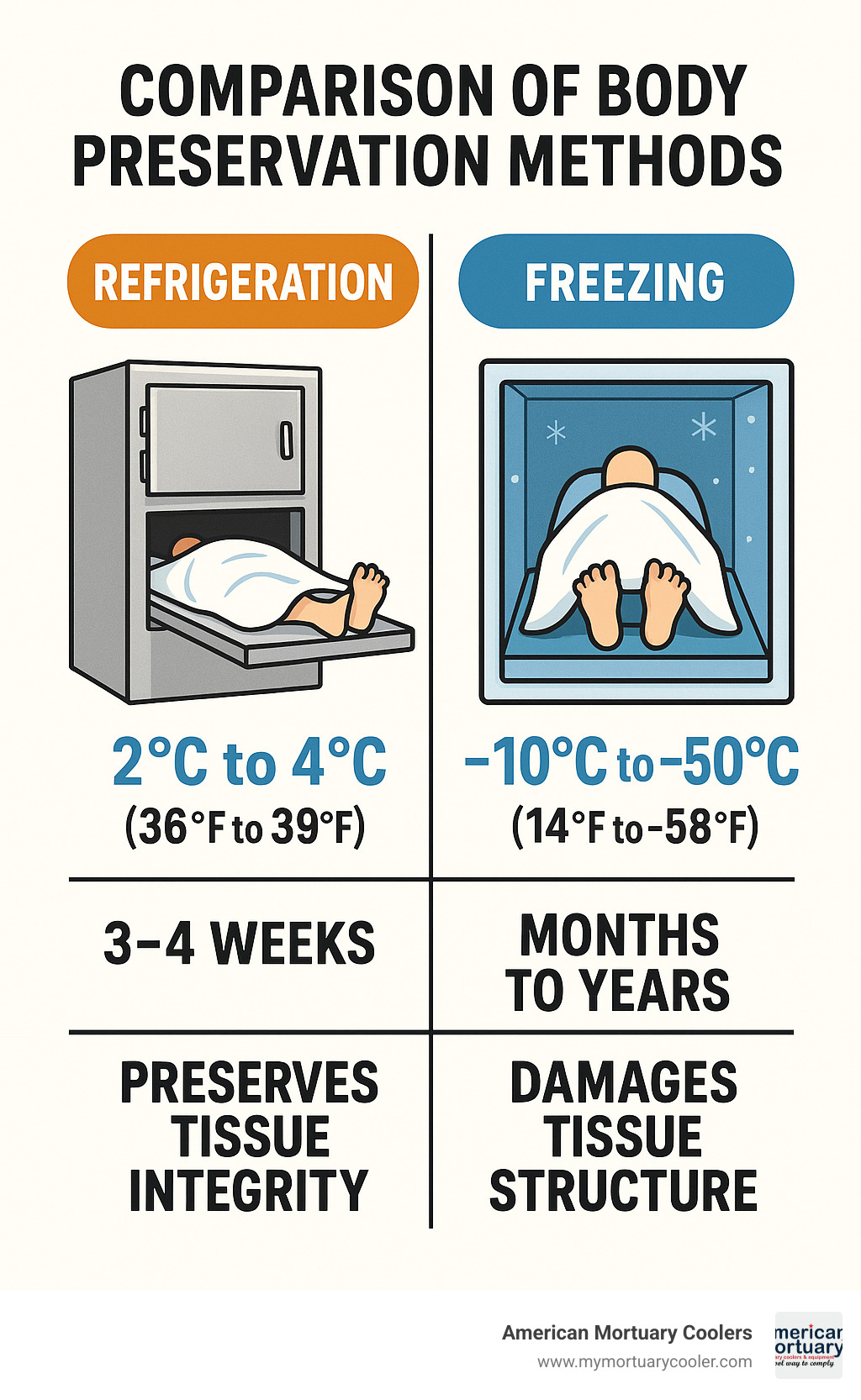
When discussing do morgues freeze bodies, you might come across these related terms:
Setting the Scene: Why Cooling Matters
Death sets in motion a series of natural changes that begin immediately. Algor mortis—the cooling of the body after death—is one of the first observable changes. At room temperature, a human body typically cools to the touch in about 12 hours and reaches core cooling within 24 hours. Meanwhile, rigor mortis—the familiar stiffening of muscles—begins approximately 3 hours after death, reaches its peak at 12 hours, and then gradually dissipates over the next 48-60 hours.
Without proper cooling, visible decomposition can begin surprisingly quickly—within 24-48 hours depending on the environment. This natural timeline creates real challenges for families who need time to gather from far away, for medical examiners who must complete thorough examinations, and for funeral directors planning meaningful services.
As the Australian Museum's research on decomposition notes, "Death begins when the heart stops beating. Deprived of oxygen, a cascade of cellular death commences." This natural process waits for no one, which is precisely why proper cooling isn't just a technical necessity—it's a compassionate service that gives families the time they need during one of life's most difficult transitions.
Do Morgues Freeze Bodies? Myth vs Reality
The idea that morgues keep bodies in freezing compartments has taken root in our collective imagination. We've all seen those TV shows where the medical examiner dramatically pulls open a drawer, releasing clouds of vapor as they reveal the deceased. It's a powerful image – but is it accurate?
As it turns out, Hollywood has been playing fast and loose with the facts. The truth about morgue storage is both more practical and scientifically sound than what we see on screen.
Do Morgues Freeze Bodies or Just Chill Them?
The simple answer? Most morgues don't freeze bodies – they refrigerate them.
Standard morgues maintain bodies at temperatures between 2°C and 4°C (36°F to 39°F), which is cold but definitely not freezing. This carefully chosen temperature range accomplishes several important goals at once:
It dramatically slows bacterial growth without causing the cellular damage that freezing would create. The cool environment significantly reduces enzymatic activity that drives decomposition while preserving the body's condition for identification, medical examination, and family viewing. Perhaps most practically, it also helps control odors while maintaining tissue integrity.
In my years consulting with funeral homes and hospitals across the country, I've observed that most facilities rely exclusively on refrigeration units. These standard coolers are perfectly sufficient for the typical timeframe bodies remain in a morgue's care.
"A refrigerated body (not frozen) will last three to four weeks before significant decomposition occurs," according to industry standards. This window comfortably accommodates most situations – allowing families time to gather, paperwork to be processed, and necessary procedures to be completed.
True freezing storage does exist, but it's specialized. Some forensic facilities, research institutions, and medical examiner offices with unusually large caseloads maintain negative-temperature freezers (typically -10°C to -20°C). These specialized units serve specific purposes: preserving unidentified remains for extended periods, maintaining evidence integrity in criminal cases, or managing overflow during mass fatality events.
Why Hollywood Thinks Morgues Freeze Bodies
The "CSI effect" has dramatically shaped how the public perceives forensic procedures. Television producers understand that billowing vapor clouds make for compelling visuals when a character dramatically slides open a morgue drawer. The clinical reality of well-organized refrigeration units simply doesn't create the same emotional impact.
If you were to visit an actual morgue and watch someone open a refrigerated drawer, you'd likely be disappointed by the lack of special effects. The temperature difference between the cooler and room temperature isn't extreme enough to create those dramatic vapor clouds. Modern units are specifically designed for temperature stability with minimal air exchange.
Writers and directors consistently take creative liberties with scientific reality. The image of the medical examiner bundled up against freezing temperatures while examining bodies creates a sense of isolation and clinical detachment that serves storytelling purposes. The truth – professionals working comfortably in standard scrubs in a cool but not freezing environment – simply doesn't build the same dramatic tension.
This disconnect between fiction and reality explains why so many people ask "do morgues freeze bodies?" The theatrical version has simply become more familiar than the practical truth. At American Mortuary Coolers, we frequently explain to new clients that standard refrigeration, not freezing, is the industry norm for the vast majority of facilities – something Hollywood hasn't quite caught up with yet.
Positive vs Negative: How Temperature Controls Decomposition
When someone dies, the clock starts ticking on a process as natural as it is inevitable. Understanding how temperature affects decomposition helps explain why morgues choose specific cooling methods rather than simply freezing everything. The human body begins its journey back to nature immediately after death through two main processes – autolysis (where the body's own enzymes break down cells from within) and putrefaction (where bacteria, primarily from the intestines, multiply and spread throughout the body).
Temperature directly impacts how quickly these processes unfold. Cooling slows both enzymatic activity and bacterial growth, while extreme cold can bring them to a near standstill.
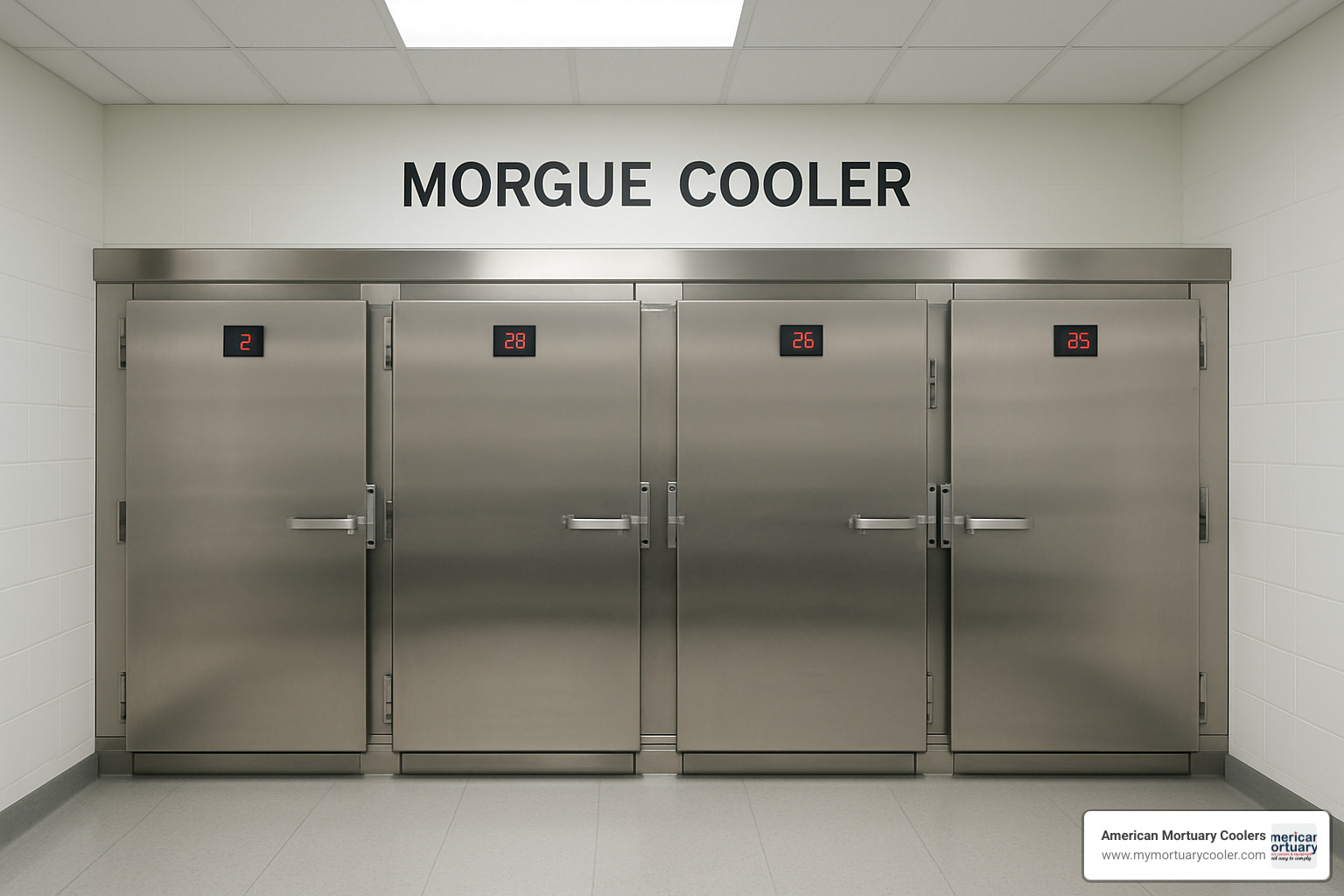
Refrigeration (Positive Temperature)
Most morgues operate in what we call the "positive temperature" range – above freezing but well below room temperature. These standard refrigeration units maintain temperatures between 2°C and 4°C (36°F to 39°F), creating an environment that's cool but not frozen.
At these temperatures, bacterial growth slows to a crawl but doesn't completely stop. Enzymatic decomposition continues at a greatly reduced rate, which is actually preferable for most situations. The body's tissues remain pliable and natural in appearance, allowing for examination, autopsy, or preparation for viewing without any need for thawing.
Hospital protocols typically emphasize placing bodies in refrigeration within 4-6 hours after death. As Lee Webster, an expert in body preservation techniques, notes, "Cooling the body within the first four to six hours following death helps to achieve a much better outcome." This timeline is critical, particularly if viewing or autopsy is anticipated.
With proper refrigeration, most facilities can store bodies for 3-4 weeks before significant decomposition becomes evident. This timeframe comfortably accommodates most funeral planning needs, allowing families to gather from distant locations and for necessary procedures to be completed.
Freezing (Negative Temperature)
In certain specialized circumstances, do morgues freeze bodies instead of refrigerating them? Yes, but only in specific situations using specialized morgue freezers that operate at temperatures ranging from -10°C to -50°C (14°F to -58°F).
True freezing effectively halts bacterial activity (though it doesn't kill all bacteria) and significantly reduces enzymatic decomposition. This approach can preserve tissues for months to years – far longer than standard refrigeration. However, freezing creates ice crystals within cells that can damage tissue structure.
According to research published in the Journal of Forensic Science and Medicine, "Freezing leads to extended extracellular spaces and shrunken cells, with more pronounced changes at lower temperatures and longer durations." These histological changes can impact subsequent examinations and procedures.
Negative-temperature storage serves specific purposes like long-term storage of unidentified remains, preservation of evidence in criminal cases, response to mass disasters when bodies exceed standard morgue capacity, and research purposes where long-term preservation is necessary.
Interestingly, a study in the International Journal of Legal Medicine found that "a single freeze–thaw cycle with four months of storage at –20°C does not significantly bias skeletal muscle protein degradation patterns." This suggests that forensic analysis remains valid even after freezing – an important consideration for criminal cases where evidence preservation is paramount. For more detailed information about freezer temperatures, check out Morgue Freezer Temperature 101: How Cold is a Morgue Freezer?
Comparing Refrigeration vs Freezing
| Aspect | Refrigeration (2-4°C) | Freezing (-10°C to -50°C) |
|---|---|---|
| Duration | 3-4 weeks | Months to years |
| Tissue Effects | Minimal changes, tissues remain pliable | Ice crystal formation, cellular damage |
| Energy Consumption | Moderate | High (2-3x refrigeration) |
| Thawing Required | No | Yes, before examination or preparation |
| Autopsy Impact | Minimal | May create artifacts and complicate findings |
| Primary Use Cases | Standard storage, autopsy preparation | Long-term storage, evidence preservation |
| Equipment Cost | $15,000-$30,000 for standard units | $40,000-$80,000 for specialized freezers |
The formation of adipocere, a waxy substance that can develop during decomposition, is also affected by temperature conditions. In refrigerated environments, adipocere formation is slowed but not prevented, while freezing temperatures can almost completely halt this process. Some psychrobacteria (cold-loving bacteria) can still function at refrigeration temperatures, though at a much slower rate than at room temperature.
When considering do morgues freeze bodies, the answer depends on the specific needs of the facility. Standard morgues typically choose refrigeration for its practical benefits and lower operational costs, while specialized forensic facilities may invest in freezing technology for specific long-term preservation needs. For the latest scientific research on this topic, you might find Scientific research on frozen corpses particularly informative.
When Freezing Is Mandatory: Forensics, Pandemics, Long-Term Storage
While refrigeration is the standard for most morgue operations, certain circumstances make true freezing conditions necessary. These specialized situations show why both refrigeration and freezing capabilities exist within the mortuary ecosystem.
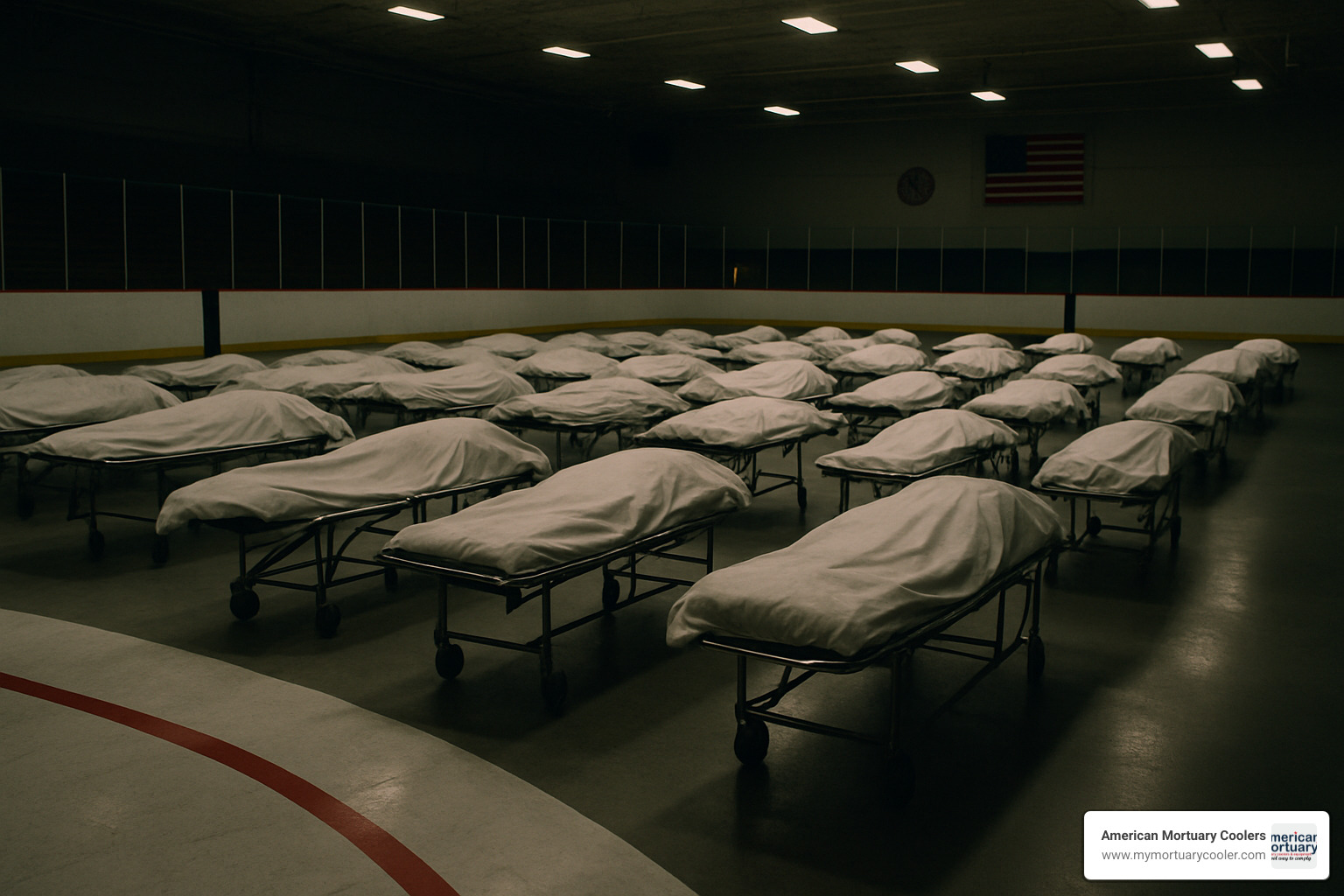
Legal Holds & Criminal Investigations
When a death becomes part of a criminal investigation, preserving evidence becomes the top priority. In homicide cases or suspicious deaths, bodies might need to be kept for weeks or months while detectives piece together what happened.
Do morgues freeze bodies in criminal cases? Yes, and for good reason. Negative-temperature chambers become essential when multiple specialists need to examine the same evidence, or when court proceedings face significant delays.
"Forensic institutes may require freezers below 32°F, whereas standard mortuaries operate at 36–39°F," according to industry research. This temperature difference isn't arbitrary – it reflects the distinct needs these facilities serve.
The chain of custody is particularly important in these cases. Each time the body is moved or examined, detailed documentation must follow. The preservation method becomes part of this documentation, with freezing ensuring that evidence remains as unchanged as possible over extended periods.
Mass Fatality Events & Overflow Planning
The COVID-19 pandemic showed us all how quickly standard morgue capacity can be overwhelmed. During those difficult months, many cities turned to creative solutions when death rates exceeded normal capacity.
Refrigerated trailers became a common sight outside hospitals, typically set to 35-39°F rather than freezing temperatures. In some particularly hard-hit areas, ice rinks were converted into temporary morgues – a practical solution that leveraged existing cooling infrastructure.
FEMA guidelines recommend that mass fatality planning include both refrigeration and freezing options. While refrigerated trailers serve as the first response, specialized freezer units become necessary for cases that can't be processed quickly.
As one morgue director shared during the pandemic, "We never imagined needing this much capacity, but the refrigerated trucks gave us breathing room to handle the surge with dignity." These temporary solutions highlight how mortuary services must sometimes adapt quickly to extraordinary circumstances.
Unclaimed or Overseas Repatriation Cases
Perhaps the most common reason for long-term freezer storage involves unclaimed remains or international transportation issues. When a body remains unidentified or when family members can't be located, morgues might need to store remains for months or even years.
International deaths create particularly complex challenges. When someone passes away abroad, a web of regulations, insurance requirements, and diplomatic processes can significantly delay bringing them home. In these situations, freezing becomes necessary to maintain the body's condition during extended delays.
"In some countries, burial must occur within 72 hours of death, but in others, bodies may be stored in morgues for weeks or months, especially if frozen," notes comparative research on international mortuary practices. These varying timelines create logistical puzzles that freezing helps solve.
The emotional toll of these delays can be significant for families waiting for their loved ones to return home. Proper preservation provides some comfort, knowing their family member is being respectfully maintained while bureaucratic problems are cleared.
At American Mortuary Coolers, we've worked with facilities facing all these specialized storage needs, designing custom solutions that provide the right temperature environment for each unique situation. Whether a facility needs standard refrigeration or specialized freezing capabilities, having reliable equipment makes all the difference in these sensitive circumstances.
Freezing vs Refrigeration: Equipment, Costs & Energy Footprint
When it comes to preserving the deceased, the choice between refrigeration and freezing involves much more than just turning a temperature dial. The equipment, operating costs, and environmental impact differ dramatically between these two preservation methods.
Having worked with funeral homes and medical facilities across the country, I've seen how these practical considerations shape decisions about morgue cooling systems.
Inside a Morgue Freezer
Step into a modern morgue freezer and you'll find yourself surrounded by sophisticated technology specifically engineered for long-term body preservation. Unlike the dramatic freezers portrayed in television shows, real morgue freezers are clinical, efficient, and built for reliability.
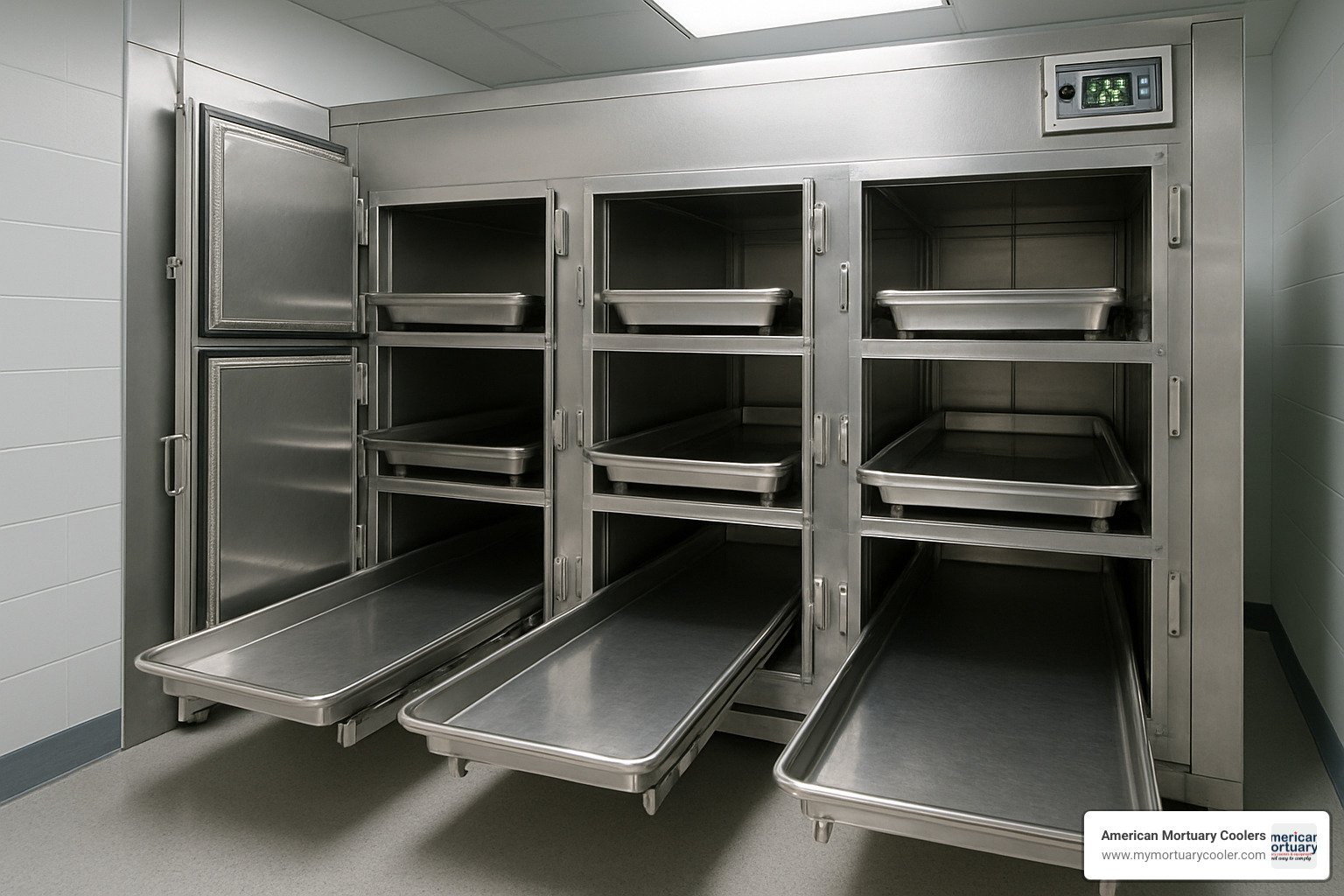
At the heart of these systems are heavy-duty compressors capable of maintaining temperatures as low as -50°C—far colder than your home freezer. These units are monitored by digital systems that continuously log temperatures and trigger alarms if readings fall outside acceptable ranges. This level of monitoring is crucial when preserving evidence in forensic cases or maintaining remains for extended periods.
The physical construction is equally impressive. Thick insulation (typically 6-8 inches compared to the 3-4 inches found in refrigeration units) surrounds the chamber, while reinforced door seals prevent temperature fluctuations. Everything inside is built from stainless steel—from the walls to the body trays—allowing for thorough sanitization between uses.
"Modern morgue freezers use two temperature regimes: positive (2–4°C) for short-term storage and negative (–10 to –50°C) for longer forensic preservation," according to research on mortuary equipment. This flexibility allows facilities to adapt to different preservation needs without maintaining separate units.
Dollars & Kilowatts
The financial and environmental differences between refrigeration and freezing are substantial—something every facility manager quickly finds when reviewing their utility bills.
From a pure equipment standpoint, freezers demand a significantly higher investment. While standard morgue refrigeration units typically cost between $15,000-$30,000 for a three-body capacity, comparable freezer units run $40,000-$80,000. For larger facilities, walk-in coolers start around $50,000, while walk-in freezers begin at $80,000 and can easily exceed $150,000 depending on size and features.
The energy consumption tells an even more dramatic story. Do morgues freeze bodies at a reasonable cost? Not really—freezer units consume 5-15 kWh per body per day, which is two to three times more energy than refrigeration units that use 2-5 kWh. This translates to an annual operating cost difference of $500-$2,000 per body capacity.
Emergency preparedness adds another layer of complexity. Freezers require substantially more powerful generators as backup power sources, and power outages pose greater risks to frozen remains. If a refrigeration unit loses power, you have more time before temperatures rise to dangerous levels compared to a freezer, which begins warming immediately.
From a sustainability perspective, refrigeration clearly wins. The carbon footprint of operating freezer units is significantly higher, especially in regions where electricity comes primarily from fossil fuels. Facilities looking to reduce their environmental impact often prioritize efficient refrigeration over freezing when possible.
Limitations & Potential Issues
While freezing can preserve bodies for longer periods, it creates several challenges that refrigeration avoids—challenges I've seen cause real headaches for medical examiners and funeral directors alike.
Perhaps the most significant issue involves freeze-thaw artifacts. When body tissues freeze, ice crystals form within cells, potentially rupturing cell membranes and creating distinctive cellular changes. Research published in forensic journals documents that freezing creates "extended extracellular spaces and shrunken cells." These histological alterations can complicate autopsy findings and forensic interpretations.
This tissue damage affects more than just scientific examinations. It can impact:
- The appearance of the body for family viewings
- The quality of tissue samples for laboratory analysis
- The effectiveness of subsequent embalming procedures
For medical examiners and pathologists, frozen bodies present workflow challenges as well. Before autopsy, a frozen body must be completely thawed—a process that can take 24-48 hours depending on body size. This delay impacts scheduling and can create bottlenecks in busy facilities.
"Careful handling and minimal movement during thawing are essential to avoid artifactual damage that could be mistaken for hemorrhage on CT angiography," notes research on postmortem imaging. These technical considerations highlight why many facilities prefer refrigeration when possible.
The practical reality is that both refrigeration and freezing have their place in modern mortuary science. Understanding the equipment differences, cost implications, and potential limitations helps facilities make informed choices based on their specific needs rather than assumptions about whether do morgues freeze bodies as standard practice.
For facilities considering their options, the Keeping Cool: Everything You Need to Know About Mortuary Freezers guide provides additional insights into equipment selection.
Legal, Cultural, and FAQ Round-Up
Beyond the technical aspects of body preservation, there's a whole world of legal requirements, cultural traditions, and practical questions to consider. As I've worked with funeral homes across the country, these are the questions that come up most frequently when discussing morgue refrigeration and freezing.
FAQ #1: How long can a body stay refrigerated before burial?
In my experience helping funeral directors set up proper cooling systems, the standard refrigeration window of 3-4 weeks provides ample time for most situations. This timeline depends on several factors that affect each case uniquely.
The body's condition at the time of refrigeration plays a major role - someone who passed peacefully in their sleep will preserve differently than someone recovered after trauma. Timing matters tremendously too - bodies refrigerated within hours of death maintain their condition much better than those that experience delays.
I've noticed that individual factors like body weight and pre-existing medical conditions can significantly impact preservation timelines. Larger bodies with higher water content may decompose more rapidly, while certain medications or medical treatments can either accelerate or slow the process.
While the federal government doesn't specify timeframes, most states have implemented their own rules. Generally, bodies must be either refrigerated or embalmed within 24-48 hours after death. The typical timeline from death to funeral service ranges from 3-7 days, aligning perfectly with standard refrigeration capabilities.
Some states have created their own unique requirements. Delaware requires disposition within 5 days, while Washington DC extends this to 7 days. North Dakota takes a different approach, prohibiting refrigeration entirely and requiring disposition within 8 days. Ohio has special rules for bodies with communicable diseases, requiring disposition within 24 hours.
FAQ #2: Is freezing allowed in every U.S. state?
The patchwork of state regulations regarding do morgues freeze bodies can be confusing for funeral professionals. While most states permit both refrigeration and freezing, there are notable exceptions and variations.
North Dakota stands out with its explicit prohibition of refrigeration as a preservation method. Most other states recognize both refrigeration and embalming as acceptable practices, though some specify exact temperature requirements (typically 35-40°F) for proper refrigeration. Urban funeral homes may face additional requirements from local health departments, especially in densely populated areas.
Religious traditions add another layer of consideration. In my work with diverse communities, I've seen how different faith practices impact preservation choices:
Jewish tradition generally avoids embalming and emphasizes prompt burial, making short-term refrigeration the preferred option. Islamic practice similarly emphasizes burial within 24 hours when possible, minimizing the need for extended preservation. Some Buddhist traditions prefer that the body remain undisturbed for several days after death, making refrigeration necessary in warmer climates where decomposition would otherwise progress rapidly.
These cultural and religious factors often guide families' decisions about preservation methods, and funeral directors must be sensitive to these preferences while working within legal requirements.
FAQ #3: Does freezing permanently stop decomposition?
This is perhaps the most common misconception I encounter when discussing do morgues freeze bodies with new funeral professionals. The simple answer is no - freezing only temporarily halts decomposition.
Once a frozen body thaws, decomposition not only resumes but often accelerates due to the cellular damage caused by ice crystal formation. The bacteria responsible for decomposition don't die during freezing; they simply become dormant. Upon thawing, these microorganisms quickly reactivate and multiply, sometimes at an increased rate.
This is why proper handling during thawing is so critical. Bodies must be thawed under controlled conditions, ideally in refrigerated environments, to minimize the acceleration of decomposition. At American Mortuary Coolers, we often recommend a gradual transition from freezing to refrigeration temperatures rather than a rapid thaw at room temperature.
For forensic purposes, this distinction matters greatly. Freezing dramatically reduces the rate of decomposition but doesn't stop it entirely. This affects determinations of time of death and other critical forensic analyses that investigators rely on.
The environmental impact of freezing versus refrigeration also deserves consideration. Freezers consume significantly more energy than refrigeration units, leading to higher operating costs and a larger carbon footprint. Some funeral homes are now exploring more sustainable approaches, including dry ice as an alternative cooling method for short-term preservation needs.
Conclusion, Key Takeaways & Next Steps
After exploring the science and practicalities of morgue refrigeration, we can put to rest many of the misconceptions perpetuated by Hollywood. The truth about how we care for the deceased is both more practical and more respectful than what appears on screen.
Standard morgues refrigerate rather than freeze bodies. This isn't just a technical distinction—it represents the careful balance between preservation and maintaining the natural integrity of human remains. Those cool rooms maintaining 2-4°C (36-39°F) provide the dignity families deserve while giving them precious time to gather and make arrangements.
Freezing is reserved for special circumstances, not everyday storage. When a forensic case requires months of preservation, when disaster strikes and overwhelms local resources, or when international repatriation faces delays—that's when negative-temperature storage becomes necessary. These specialized freezers operating at -10°C to -50°C serve critical needs but represent a small portion of mortuary operations nationwide.
Most families can take comfort knowing refrigeration preserves their loved one's body for 3-4 weeks—plenty of time for normal funeral planning, identification, and any necessary examinations. This timeline balances practical considerations with emotional needs, giving families the space to process their loss without rushing important decisions.
The science behind these choices matters too. Freezing creates cellular changes that can complicate later procedures. Those ice crystals forming within tissues don't just affect appearance—they can impact everything from autopsy findings to embalming effectiveness. Refrigeration offers preservation without these complications.
From an operational standpoint, the difference between these methods is substantial. Freezers demand more investment upfront and consume 2-3 times more energy throughout their lifespan. For most facilities, refrigeration provides the optimal balance of effectiveness, cost, and environmental responsibility.
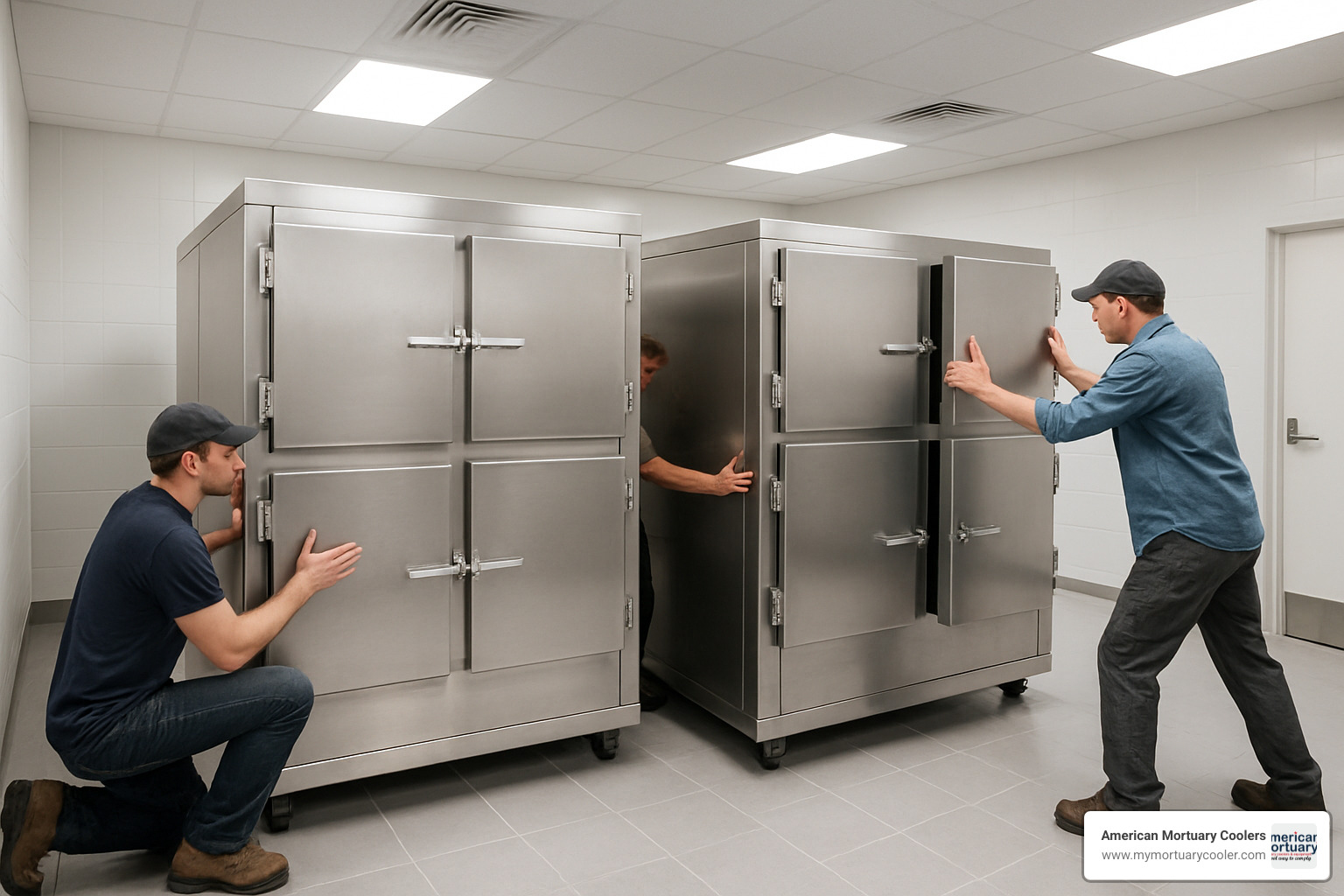
Here at American Mortuary Coolers, we've spent years helping funeral homes, hospitals, and medical examiners find the right temperature-controlled solutions for their specific needs. We understand that behind every technical specification is a family in grief, waiting for time with their loved one. That's why we design our custom mortuary coolers with both precision cooling and human dignity in mind.
If your facility is considering updating its preservation capabilities, I recommend speaking with specialists who understand both the science and the sensitive nature of your work. Our team provides customized solutions with direct delivery across all 48 contiguous states, ensuring you have the right equipment to provide respectful, efficient care.
The technology of body preservation continues to advance, but the core principle remains unchanged: providing dignified care during a difficult time. With the right cooling systems in place, funeral professionals can give families the time they need while maintaining the integrity of those in their care.
For a deeper dive into available options, our Complete Guide to Freezer Morgue Options offers additional insights, or you're welcome to reach out for personalized guidance.
Do morgues freeze bodies? Now you know the nuanced answer—and understand the thoughtful science behind how we care for the deceased with both technical precision and human compassion.



